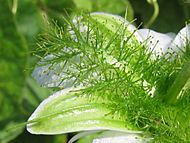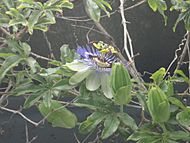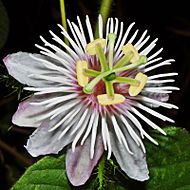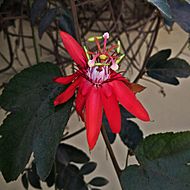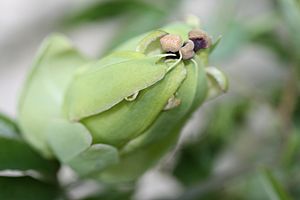Passiflora facts for kids
Quick facts for kids Passiflora |
|
|---|---|
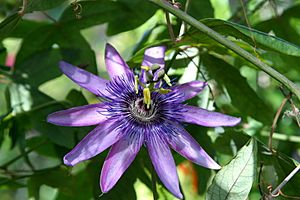 |
|
| Passiflora × kewensis | |
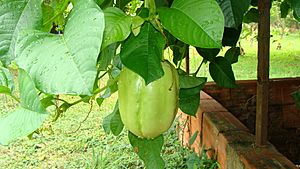 |
|
| P. platyloba fruit , often confused with P. quadrangularis | |
| Scientific classification | |
| Kingdom: | |
| (unranked): | |
| (unranked): | |
| (unranked): | |
| Order: | |
| Family: | |
| Genus: |
Passiflora
|
| Species | |
|
About 500, see list |
|
| Synonyms | |
|
|
Passiflora, also known as passion flowers or passion vines, is a group of about 550 different species of flowering plants. It is the main group in the plant family called Passifloraceae.
Most passion flowers are tendril-bearing vines. This means they have special parts that help them climb. Some can also grow as shrubs or even small trees. Their stems can be woody or soft and herbaceous. Passion flowers are known for their beautiful and often very showy flowers. These flowers have a special ring-like part called a corona. The flowers usually have five parts and grow into a fruit with many seeds. To learn more about the fruit, check out the article on passionfruit.
Contents
Where Passion Flowers Grow
Most Passiflora plants grow in warm, tropical parts of the world. They are mainly found in Mexico, Central and South America. You can also find some species in the United States, Southeast Asia, and Oceania. Scientists are still discovering new types of passion flowers. For example, P. xishuangbannaensis and P. pardifolia were only found in 2005 and 2006.
Some passion flower species have started growing in new places. This happens when their seeds are carried to areas outside their natural home. For instance, the blue passion flower (P. caerulea) now grows wild in Spain. The purple passionfruit (P. edulis) is grown in many tropical areas for its tasty fruit.
Passion Flower Ecology
Passion flowers have special flower shapes. Because of this, they usually need animals to help them with pollination. Pollinators are animals that carry pollen from one flower to another. For passion flowers, these helpers include bumblebees, carpenter bees, wasps, bats, and hummingbirds. Some passion flowers can also pollinate themselves.
Many passion flower species rely on very specific pollinators. This has led to a process called coevolution. This means the plant and the pollinator have evolved together over time. A great example is the sword-billed hummingbird (Ensifera ensifera). This bird has a super long beak. It is the only pollinator for 37 species of Passiflora that grow high in the Andes mountains.
Insects and Passion Flowers
The leaves of passion flowers are a food source for the larvae (caterpillars) of many Lepidoptera species. These include many types of butterflies from the Heliconiini group.
Passion flowers have developed many ways to protect themselves from insects. Their leaves come in many different shapes, which helps to hide them. Some have colored bumps that look like butterfly eggs. This can trick butterflies into thinking the leaf is already full, so they don't lay their own eggs there. They also have sticky hairs, different colors on their leaves, and special chemicals to keep insects away. These amazing defenses, along with the ways butterflies have adapted, helped scientists understand coevolution.
Here are some butterfly larvae known to eat Passiflora leaves:
- Longwing butterflies (Heliconiinae)
- Cydno longwing (Heliconius cydno)
- Gulf fritillary (Agraulis vanillae)
- American Sara longwing (Heliconius sara)
- Red postman (Heliconius erato)
- Asian leopard lacewing (Cethosia cyane)
- Postman butterfly (Heliconius melpomene)
- Zebra longwing (Heliconius charithonia)
- Banded orange (Dryadula phaetusa)
- Julia butterfly (Dryas iulia)
- Swift moth Cibyra serta
The many different leaf shapes found on Passiflora plants are quite unique. You can often find leaves with no lobes, or with up to five lobes, all on the same plant! This amazing variety might be linked to how specific the plants are about their pollinators and parasites.
Special Defenses
The bracts (special leaves near the flower) of the stinking passion flower are covered in sticky hairs. These hairs release a sticky liquid. Small insects get stuck to this fluid and are then broken down by special chemicals. This makes the stinking passion flower a protocarnivorous plant. It means it can catch and digest insects, but it's not a true carnivorous plant like a Venus flytrap.
Invasive and Endangered Species
The Banana passionfruit (P. tarminiana) is a type of passion flower from Central Brazil. It has become an invasive weed in some places, especially in Hawaii. It spreads easily when wild pigs eat its fruits. This plant can grow very fast and cover other native plants, which harms the local environment. The Blue passion flower (P. caerulea) is also spreading in Spain and needs to be watched.
On the other hand, some passion flower species are endangered. This means they are at risk of disappearing forever. This is often due to too much logging and other ways that their natural homes are being destroyed. For example, the Chilean passion flower (P. pinnatistipula) is a rare vine. It grows in the Andes mountains and in Chilean Mediterranean forests.
How People Use Passion Flowers
For Beauty
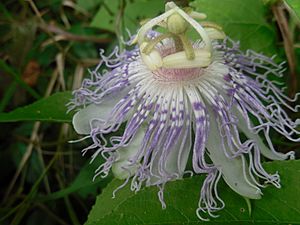
Many types of Passiflora are grown in gardens around the world. People love them for their beautiful flowers and sometimes for their fruit. There are hundreds of different hybrid passion flowers. These are new types created by mixing different species. The goal is to get new flowers, leaves, or fruits. Some popular types have even won awards, like 'Amethyst' and P. × exoniensis.
In the Victorian era, passion flowers were very popular. Many new types were created back then. Even today, some passion flowers that like cooler weather can grow well in places like California and even Sweden.
Passion flowers have also been studied by scientists to understand how plants pass on their genes.
The French name for passion flowers, Passiflore, inspired a popular children's book series called La Famille Passiflore. These books were later made into an animated TV show and translated into English as Beechwood Bunny Tales.
For Fruit
Most passion flower species have round or long fruits. These fruits can be from two to eight inches long. Many of them are edible.
- The passion fruit (or maracujá) is grown a lot in the Caribbean, South America, and South Africa. Its fruit is used to make juice. There is a small pink type and a larger yellow or orange type.
- Sweet granadilla (P. ligularis) is another widely grown species. In some parts of Africa and Australia, this is the plant people call "passionfruit." Its fruit is a mix between the two types of P. edulis.
- Maypop (P. incarnata) is common in the southeastern US. This plant can handle cold weather, even down to -20°C. Its fruit is sweet, yellowish, and about the size of a chicken's egg. It's a popular native plant because its fruit is tasty and it doesn't have many pests.
- Giant granadilla (P. quadrangularis), water lemon (P. laurifolia), and sweet calabash (P. maliformis) are other passion flower species known for their fruits in certain areas.
- Wild maracuja are the fruits of P. foetida. They are popular in Southeast Asia.
- Banana passionfruits are the long fruits of P. tripartita var. mollissima and P. tarminiana. These are eaten locally. However, they can be invasive, so it's not a good idea to grow them outside their native areas.
Images for kids
-
Passiflora incarnata, one of the most common passion flowers
-
Ripe fruits of Passiflora edulis
See also
 In Spanish: Passiflora para niños
In Spanish: Passiflora para niños


